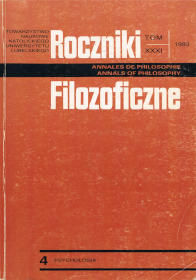The Structure of Similarity in Perception Categorization: Simulation of the Process of Formation of a Cognitive Representation of the Category
Abstract
The aim of the present paper is to construct a model of formation of a cognitive representation of the category. The task was accomplished on the basis of a computer simulation of categorization adjusted to the results of empirical studies. The process of formation of a cognitive structure of the category was expressed in terms of the exemplar theory of categorization and in precisely defined relations of similarities between the perceived stimuli. The analysis of the process was carried out according to the optimization procedure that had been worked out. The procedure was applied to the results of experimental studies on perception categorization.
The optimization procedure revealed the inner, unobservable mechanism of formation of a cognitive structure of the outward experimental environment expressed by the dynamics of changes in the similarities between the categorized stimuli. The results of the studies were interpreted in terms of the cognitive-motivation conception of similarity ⟨Falkowski 1990a⟩, the theory of the cognitive dissonance ⟨Festinger 1957⟩ and the ecological theory of perception ⟨Gibson 1979⟩.
References
Brooks L. R.: Conceptual Development and Category Structure. W: U. Neisser (Ed.). Concepts and Conceptual Development: Ecological and Intellectual Factors in Categorization. Cambridge 1987. Cambridge University Press.
ChlewińskiZ.,FalkowskiA.: Cechy i relacje w prototypowym i egzemplarzowym modelu kategoryzacji. „Prakseologia” 1992 nr 3-4 s. 49-77.
Falkowski A.: Podobieństwo poznawcze w kategoryzacji percepcyjnej: badania empiryczne w egzemplarzowym modelu kategoryzacji. „Przegląd Psychologiczny” 33:1990 s. 293-312.
Falkowski A.: Relacja podobieństwa w procesach poznawczych: Ekologiczne i informacyjne podejście w psychologii. Lublin 1990a. RW KUL.
Falkowski A., Feret B.: Prototype and Exemplar Models in Categorization. A Simulatory Comparative Analysis. ”Polish Psychological Bulletin” 21:1990 s. 199-211.
Festinger L.: A Theory of Cognitive Dissonance. Stanford 1957. Stanford Uniwersity Press.
FlannaganM.J.,FriedL.S.,HolyoakK.J.: Distributional Expectation andthe Induction of Category Structure. ”Journal of Experimental Psychology: Learning, Memory, and Cognition” 12:1986 s. 241-256.
FriedL.S.,HolyoakK.S. : Induction of Category Distributions: A Framework for Classification Learning. ”Journal of Experimental Psychology: Learning, Memory, and Cognition” 10:1984 s. 234-257.
Gibson J. J.: The Ecological Approach to Visual Perception. Boston 1979. Houghton Mifflin.
Luce R. D.: Detection and Recognition. W: R. D. Luce, R.R.Bush, E.Galanter (Eds). Handbook of Mathematical Psychology. Vol. 1. New York 1963. Wiley.
MedinD.L.,SchafferM.M.: Context Theory of Classification Learning. ”Psychological Review” 85:1978 s. 207-238.
Miller G. A.: Trends and Debates in Cognitive Psychology. ”Cognition” 10:1981 s. 215-225.
MurphyG.L.,MedinD.L.: The Role of Theories in Conceptual Coherence. ”Psychological Review” 92:1985 s. 289-316.
NosofskyR.M.: Choice, Similarity, and the Context Theory of Classification. ”Journal of Experimental Psychology: Learning, Memory, and Cognition” 10:1984 s. 104-114.
NosofskyR.M.: Attention, Similarity, and the Identification-Categorization Relationship. ”Journal of Experimental Psychology: General” 1986 No 115 s. 39-57.
NosofskyR.M.: Attention and Learning Processes in the Identification and Categorization of Integral Stimuli. ”Journal of Experimental Psychology”: Learning, Memory, and Cognition” 13:1987 s. 87-108.
Reed S. K.: Pattern Recognition and Categorization. ”Cognitive Psychology” 3:1972 s. 382-407.
RipsL.J.,ShobenE.J.,SmithE.E.: Semantic Distance and the Verification of Semantic Relations. ”Journal of Verbal Learning and Verbal Behavior” 12:1973 s. 1-20.
RoschE.,MervisC.B.: Family Resemblance: Studies in the Internal Structure of Categories. ”Cognitive Psychology” 7:1975 s. 573-605.
RoschE.,SimpsonC.,MillerR.S.: Structural Bases of Typicality Effects. ”Journal of Experimental Psychology: Human Perception and Performance” 2:1976 s. 491-502.
SelfridgeO.G.,NeisserU.:Pattern Recognition by Machine. ”Scientific American” 1960 No 203 s. 60-68.
SmithE.E.,ShobenE.J.,RipsL.J.: Structure and Processes in Semantic Memory: A Featural Model for Semantic Decisions. ”Psychological Review” 81:1974 s. 214-241.
ShepardR.N.,HovlandC.I.,JenkinsH.M.: Learning and Memorizationof Classifications. ”Psychological Monographs” 75:1961 (cały numer 517).
TakaneY.,CarrolJ.P.: Multidimensional Scaling from the Tree Construction Method of Similarity Data. Paper presented at the Meeteng of the Psychometric Society, University of Quebeck, Montreal, Canada 1982.
Tversky A.: Features of Similarity. ”Psychological Review” 84:1977 s. 327-352.
UllmanS.: Visual Routines. W: S. Pinker (Ed.). Visual Cognition. Cambridge 1985. MIT Press.
Copyright (c) 1993 Roczniki Filozoficzne

This work is licensed under a Creative Commons Attribution-NonCommercial-NoDerivatives 4.0 International License.





